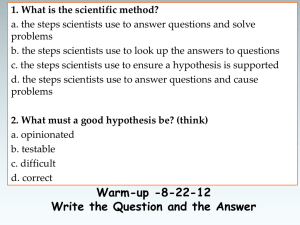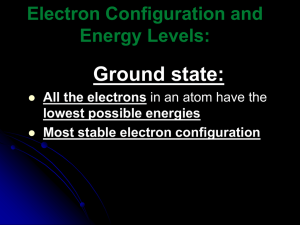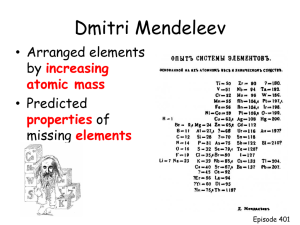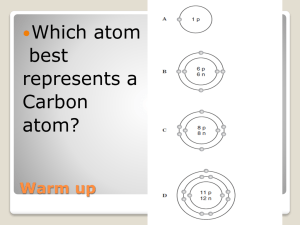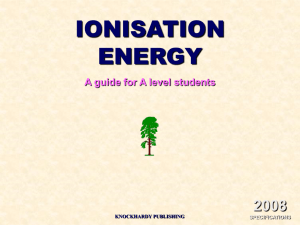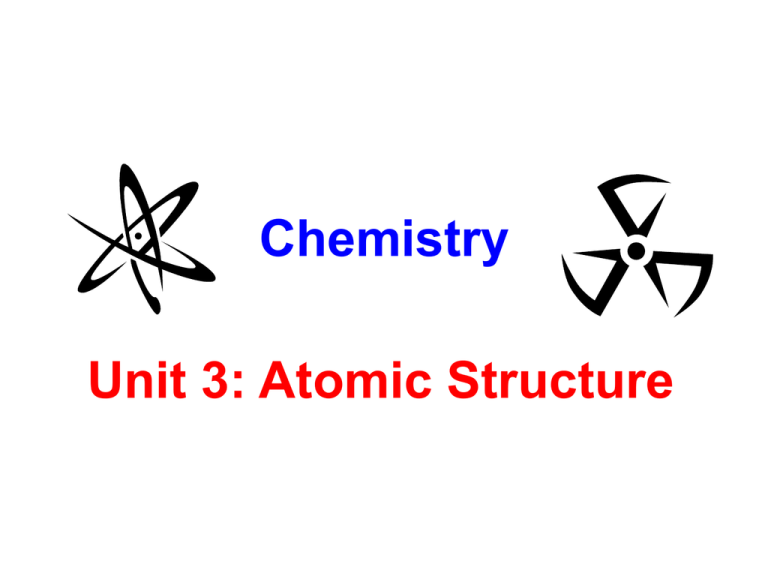
Chemistry
Unit 3: Atomic Structure
Basics of the Atom
Subatomic
Charge
Particle
Location in
the Atom
Mass
proton
1+
in nucleus
~ 1 a.m.u.
neutron
0
in nucleus
~ 1 a.m.u.
electron
1–
around nucleus ~ 0 a.m.u.
a.m.u.: unit used to measure mass of atoms
“atomic mass unit”
atomic number: # of p+
-- the whole number
on Periodic Table
-- determines identity
of the atom
10
Ne
20.1797
mass number: (# of p+) + (# of n0)
(It is NOT on “the Table.”)
To find net charge on an atom, consider
e–
p+ and ____.
____
ion: a charged atom
anion: a (–) ion
cation: a (+) ion
-- more e– than p+
-- more p+ than e–
-- formed when
atoms gain e–
-- formed when
atoms lose e–
I think that an ions are negative ions.
“When I see a cation, I see a positive ion;
that is, I… C A + ion.”
Other Mnemonic Devices
Metals form positive
ions
Cations are “paws”itive
Description
Net
Charge
Atomic
Number
Mass
Number
15 p+
16 n0
18 e–
3–
15
31
P3–
38 p+
50 n0
36 e–
2+
38
88
Sr2+
2–
52
128
Te2–
1+
19
39
K+
52 p+
76 n0
54 e–
19 p+
20 n0
18 e–
Ion
Symbol
Isotopes: different varieties of an element’s atoms
-- have diff. #’s of n0; thus, diff. mass #’s
-- some are radioactive; others aren’t
All atoms of an element react the same chemically.
p+
n0
Common Name
H–1
Mass
1
1
0
protium
H–2
2
1
1
deuterium
H–3
3
1
2
tritium
Isotope
C–12 atoms
6 p+ 6 n0
C–14 atoms
6 p+ 8 n0
stable
radioactive
Complete Atomic Designation
…gives very precise info about an atomic particle
mass #
charge (if any)
element
symbol
atomic #
125
53
Goiter due to
lack of iodine
I
–
iodine is now
added to salt
Protons
Neutrons
Electrons
92
146
92
11
12
10
34
45
36
27
32
24
17
20
18
25
30
18
Complete
Atomic
Designation
238
U
92
23
+
Na
11
79
2–
Se
34
59
3+
Co
27
37
–
Cl
17
55
7+
Mn
25
Radioactive Isotopes: have too many or too few n0
Nucleus attempts to attain a lower
energy state by releasing extra
radiation
energy as __________.
e.g., a- or b-particles, g rays
half-life: the time needed for
½ of a radioactive
sample to decay
into stable matter
e.g., C–14: half-life is 5,730 years
decays into stable N–14
Say that a 120 g
sample of C-14 is
found today…
Years
from now
0
5,730
11,460
17,190
22,920
= C–14
= N–14
g of C–14 g of N–14
present
present
120
0
60
30
60
90
15
7.5
105
112.5
Half Life Graph (Sr-90 Activity)
Average Atomic Mass (AAM)
This is the weighted average mass of all atoms of
an element, measured in a.m.u.
Ti has five naturallyoccurring isotopes
For an element with
isotopes A, B, etc.:
AAM = Mass A (% A) + Mass B (% B) + …
% abundance
(use the decimal form of the %
e.g., use 0.253 for 25.3%)
Lithium has two isotopes.
Li-6 atoms have mass 6.015 amu;
Li-7 atoms have mass 7.016 amu.
Li-6 makes up 7.5% of all Li atoms.
Find AAM of Li.
Li batteries
AAM = Mass A (% A) + Mass B (% B)
AAM = 6.015 amu (0.075) + 7.016 amu (0.925)
AAM =
0.451 amu
+
6.490 amu
AAM = 6.94 amu
** Decimal number on Table refers to…
molar mass (in g) OR AAM (in amu).
6.02 x 1023 atoms
1 “average” atom
Isotope
Mass
Si-28
Si-29
27.98 amu
28.98 amu
?
Si-30
%
abundance
92.23%
4.67%
3.10%
AAM = MA (% A) + MB (% B) + MC (% C)
28.086 = 27.98 (0.9223) + 28.98 (0.0467) + X (0.031)
28.086 =
28.086 =
0.927 =
0.031
25.806
+
1.353
27.159
X = MSi-30 = 29.90 amu
+ 0.031X
+ 0.031X
0.031X
0.031
Historical Development of the Atomic Model
Greeks (~400 B.C.E.)
Democritus & Leucippus
Matter is discontinuous (i.e., “grainy”).
“atomos” = uncuttable or indivisible
Greek model
of atom
Solid and INDESTRUCTABLE
Hints at the Scientific Atom
** Antoine Lavoisier:
law of conservation of mass
mass R = mass P
** Joseph Proust (1799):
law of definite proportions: every
compound has a fixed proportion
e.g., water…………………….. 8 g O : 1 g H
chromium (II) oxide……. 13 g Cr : 4 g O
Hints at the Scientific Atom (cont.)
** John Dalton (1803):
law of multiple proportions:
When two different compounds
have same two elements, equal
mass of one element results in
integer multiple of mass of other
2
e.g., water…………………….. 8 g O : 1 g H
hydrogen peroxide..…….16 g O : 1 g H
3
chromium (II) oxide……. 13 g Cr : 4 g O
chromium (VI) oxide……13 g Cr : 12 g O
John Dalton’s Atomic Theory (1808)
1. Elements are made of
indivisible particles called atoms.
2. Atoms of the same element are exactly
alike; in particular, they have the same mass.
3. Compounds are formed by
the joining of atoms of two
or more elements in fixed,
whole number ratios.
e.g., 1:1, 2:1, 1:3, 2:3, 1:2:1
NaCl, H2O, NH3, Fe2O3, C6H12O6
Dalton’s
model
of atom
** William Crookes
(1870s):
Rays causing
shadow were
emitted from
cathode.
Maltese cross CRT
radar screen
television
computer
monitor
J.J Thomson (~1900)
J.J. Thomson discovered
that “cathode rays” are…
…deflected by electric
and magnetic fields
electric field lines
“cathode rays”
Crooke’s tube
… (–) particles
J.J. Thomson
++++++
– – – – – –
electrons
phosphorescent
screen
William Thomson (a.k.a., Lord Kelvin):
Since atom was known to be
electrically neutral, he proposed
the plum pudding model.
-- Equal quantities of (+) and (–)
charge distributed uniformly
in atom.
Lord Kelvin
++ ++
+ ++ +
+ ++
–
–
–
–
–
-- (+) is ~2000X more massive
than (–)
plum
pudding
–
–
–
–
–
–
Thomson’s plum
pudding model
Ernest Rutherford (1909)
Gold Leaf Experiment
Beam of a-particles (+) directed
at gold leaf surrounded by
phosphorescent (ZnS) screen.
a-source
lead
block
particle
beam
ZnS
screen
gold
leaf
Most a-particles passed through, some angled
slightly, and a tiny fraction bounced back.
Conclusions:
1. Atoms are mostly empty space
2. (+) particles are concentrated at center
nucleus = “little nut”
3. (–) particles orbit nucleus
Rutherford’s
ModelModel
Dalton’s
(also
thePudding
Greek)
Thomson’s
Plum
Model
–
+
– +
+
–
– +
–
–
+
+
+
N
–
+
–
–
–
–
–
–
+– + + –
–
–
** James Chadwick
discovered neutrons in 1932
n0 have no charge
and are hard to detect
purpose of n0 = stability of nucleus
photo from liquid
H2 bubble chamber
Chadwick
And now we know of many
other subatomic particles:
quarks,
muons,
positrons,
neutrinos,
pions, etc.
Discovery of the Neutron
9
4
Be
+
4
2
He
12
6
C
+
1
0
n
James Chadwick bombarded beryllium-9 with alpha particles,
carbon-12 atoms were formed, and neutrons were emitted.
Dorin, Demmin, Gabel, Chemistry The Study of Matter 3rd Edition, page 764
*Walter Boethe
Recent Atomic Models
Max Planck (1900): Proposed that
amounts of energy are quantized
only certain values are allowed
Niels Bohr (1913): e– can possess
only certain amounts of energy, and
can therefore be only certain
distances from nucleus.
planetary
(Bohr)
model
e–
found
here
N
e– never
found here
Bohr Atom
The Planetary Model of the Atom
Bohr’s Model
Nucleus
Electron
Orbit
Energy Levels
quantum mechanical model
electron cloud model
charge cloud model
Schroedinger, Pauli, Heisenberg, Dirac (up to 1940):
According to the QMM, we never know for certain
where the e– are in an atom, but the equations of the
QMM tell us the probability that we will find an
electron within a certain distance from the nucleus.
Electron Cloud Model
• Orbital (“electron cloud”) instead of “orbits”
– Region in space where there is 90% probability
of finding an electron
90% probability of
finding the electron
Electron Probability vs. Distance
Electron Probability (%)
40
30
20
10
0
0
50
100
150
Distance from the Nucleus (pm)
Orbital
Courtesy Christy Johannesson www.nisd.net/communicationsarts/pages/chem
200
250
Models of the Atom Review
"In science, a wrong theory can be valuable and better than no theory at all."
- Sir William L. Bragg
e
e
+
e
+
e
+
+
e
+e
+
e
e
+ e + e
Dalton’s
Greek model
model
(400
(1803)
B.C.)
Thomson’s plum-pudding
model (1897)
Bohr’s model
(1913)
Dorin, Demmin, Gabel, Chemistry The Study of Matter , 3rd Edition, 1990, page 125
-
- +
Rutherford’s model
(1909)
Charge-cloud model
(present)
Models of the Atom Timeline
e
e
+
e
-
+
e
+
+
e
+e
+e
e
+ e + e
Dalton’s
model
Greek model
(1803)
(400 B.C.)
1803 John Dalton
pictures atoms as
tiny, indestructible
particles, with no
internal structure.
1800
-
Thomson’s plum-pudding
model (1897)
- +
Rutherford’s model
(1909)
1897 J.J. Thomson, a British
1911 New Zealander
scientist, discovers the electron,
leading to his "plum-pudding"
model. He pictures electrons
embedded in a sphere of
positive electric charge.
Ernest Rutherford states
that an atom has a dense,
positively charged nucleus.
Electrons move randomly in
the space around the nucleus.
1805 ..................... 1895
1900
1905
1910
1904 Hantaro Nagaoka, a
Japanese physicist, suggests
that an atom has a central
nucleus. Electrons move in
orbits like the rings around Saturn.
Dorin, Demmin, Gabel, Chemistry The Study of Matter , 3rd Edition, 1990, page 125
1915
Bohr’s model
(1913)
1926 Erwin Schrödinger
1913 In Niels Bohr's
model, the electrons move
in spherical orbits at fixed
distances from the nucleus.
1920
1925
Charge-cloud model
(present)
1930
develops mathematical
equations to describe the
motion of electrons in
atoms. His work leads to
the electron cloud model.
1935
1940
1945
1924 Frenchman Louis
1932 James
de Broglie proposes that
moving particles like electrons
have some properties of waves.
Within a few years evidence is
collected to support his idea.
Chadwick, a British
physicist, confirms the
existence of neutrons,
which have no charge.
Atomic nuclei contain
neutrons and positively
charged protons.
Light
When all e– are in lowest possible energy state,
ground state
an atom is in the ____________.
e.g., He: 2 e-, both in 1st energy level
ENERGY
(HEAT, LIGHT,
ELEC., ETC.)
If “right” amount of energy is absorbed by an e–, it can
“jump” to a higher energy level. This is an unstable,
excited state
momentary condition called the ____________.
e.g., He: 1 e- in 1st E level, 1 e- in 2nd E level
When e– falls back to a lower-energy, more stable
orbital (it might be the orbital it started out in, but it
might not), atom releases the “right” amount of
energy as light.
EMITTED
LIGHT
Any-old-value
of energy to be
absorbed or released is
NOT OK. This explains
the lines of color in an
emission spectrum.
Emission Spectrum for a Hydrogen Atom
Lyman series:
e– falls to 1st energy level
Balmer series:
e– falls to 2nd energy level
Paschen series:
e– falls to 3rd energy level
H discharge
tube, with power
supply and
spectroscope
typical emission spectrum
Lyman
(UV)
Balmer
(visible)
Paschen
(IR)
6TH E.L.
5TH E.L.
4TH E.L.
~
~
~
~
~
~
3RD E.L.
2ND E.L.
1ST E.L.
electromagnetic radiation (i.e., light)
-- waves of oscillating electric (E)
and magnetic (B) fields
-- source is… vibrating electric charges
E
B
Characteristics of a Wave
crest
amplitude A
trough
wavelength l
frequency: the number of cycles per
unit time (usually sec)
-- unit is Hz, or s–1 or 1/s
electromagnetic spectrum: contains all of the “types” of
light that vary according to frequency and wavelength
cosmic rays
gamma rays
X-rays
UV
visible
IR
microwaves
radio waves
ROYGBV
750 nm 400 nm
large l
small l
-- visible spectrum ranges from
low f
high f
only ~400 to 750 nm (a very
low energy narrow band of spectrum)
high energy
Albert Michelson (1879)
-- first to get an accurate
value for speed of light
Albert Michelson
(1852–1931)
The speed of light in
a vacuum (and in air)
is constant:
c = 3.00 x 108 m/s
-- Equation:
c=fl
In 1900, Max Planck assumed
that energy can be absorbed
or released only in certain
discrete amounts, which he
called quanta.
Later, Albert Einstein dubbed
a light “particle” that carried a
quantum of energy a photon.
-- Equation:
Max Planck
(1858–1947)
E=hf
E = energy, in J
h = Planck’s constant
= 6.63 x 10–34 J∙s (i.e., J/Hz)
Albert Einstein
(1879–1955)
A radio station transmits
at 95.5 MHz (FM 95.5).
Calculate the wavelength
of this light and the energy
of one of its photons.
8 m/s
3.00
x
10
c=fl l =
= 3.14 m
6
95.5 x 10 Hz
f
c
E = h f = 6.63 x 10–34 J/Hz (95.5 x 106 Hz)
=
6.33 x 10–26 J
Electron Cloud Model
• Orbital (“electron cloud”) instead of “orbits”
– Region in space where there is 90% probability
of finding an electron
90% probability of
finding the electron
Orbital Shape
Orbital
Courtesy Christy Johannesson www.nisd.net/communicationsarts/pages/chem
Shapes of s, p, and d orbitals
p-Orbitals
px
Zumdahl, Zumdahl, DeCoste, World of Chemistry 2002, page 335
pz
py
s, p, and d-orbitals
s orbitals:
Each holds 2
electrons
(outer orbitals of
Groups 1 and 2)
Kelter, Carr, Scott, , Chemistry: A World of Choices 1999, page 82
p orbitals:
Each of 3 sets holds
2 electrons = 6
electrons
(outer orbitals of
Groups 3 to 8)
d orbitals:
Each of 5 sets holds
2 electrons
= 10 electrons
(found in elements
in third period
and higher)
f orbitals
Relative Sizes 1s and 2s
1s
Zumdahl, Zumdahl, DeCoste, World of Chemistry 2002, page 334
2s
Copyright © 2006 Pearson Benjamin Cummings. All rights reserved.
Periodic Patterns
p block
n s block
1
2
3
4
5
6
7
1s
1s
2s
2p
d block (n-1)
3s
3p
4s
3d
4p
5s
4d
5p
6s
5d
6p
7s
6d
7p
f (n-2)
block
6
7
4f
5f
Sections of Periodic Table to Know
s-block
p-block
d-block
f-block
Energy Level Diagram of a Many-Electron Atom
6s
6p
5d
4f
32
5s
5p
4d
18
4s
4p
3d
18
Arbitrary
Energy Scale
3s
3p
8
2s
2p
Each
orbital
can only
hold 2 e-
8
Start from
the bottom
and add e-
1s
2
NUCLEUS
O’Connor, Davis, MacNab, McClellan, CHEMISTRY Experiments and Principles 1982, page 177
You don’t have to memorize the
order…just start at the
beginning and fill in e-…
Periodic Patterns
• Example - Hydrogen
1
2
3
4
5
6
7
1
1s
1st Period (row)
1 e- in “1s”
orbital
s-block
Courtesy Christy Johannesson www.nisd.net/communicationsarts/pages/chem
Writing Electron Configurations:
Where are the e–? (probably)
H
1s1
He 1s2
Li
1s2 2s1
N
1s2 2s2 2p3
Al
1s2 2s2 2p6 3s2 3p1
Ti 1s2 2s2 2p6 3s2 3p6 4s2 3d2
As 1s2 2s2 2p6 3s2 3p6 4s2 3d10 4p3
Xe 1s2 2s2 2p6 3s2 3p6 4s2 3d10 4p6 5s2 4d10 5p6
Filling
Order
1s2 2s2 2p6 3s2 3p6 4s2 3d10 4p6…
Shorthand Electron Configuration (S.E.C.)
To write S.E.C. for an element:
1. Put symbol of noble gas that precedes
element in brackets.
2. Continue writing e– config. from that point
S
[ Ne ] 3s2 3p4
Co [ Ar ] 4s2 3d7
In
[ Kr ] 5s2 4d10 5p1
32
Ge
72.61
Cl [ Ne ] 3s2 3p5
Rb [ Kr ] 5s1
Shorthand Configuration
A
neon's electron configuration (1s22s22p6)
B
3rd energy level (or 3rd period)
C
1 electron in the s orbital
D
orbital shape (s,p,d,f…etc.)
[Ne] 3s1
22s22p6] 3s1
[
1s
Na =
electron configuration
Shorthand Configuration Review
Element symbol
Electron configuration
Ca
[Ar] 4s2
V
[Ar] 4s2 3d3
F
[He] 2s2 2p5
Ag
[Kr] 5s2 4d9
I
[Kr] 5s2 4d10 5p5
Xe
[Kr] 5s2 4d10 5p6 or [Xe]
Fe
22p64s
[He] 2s[Ar]
3s223d
3p664s23d6
Sg
[Rn] 7s2 5f14 6d4
Three Principles about Electrons
3d10…
4s2
3p6
3s2
Aufbau Principle:
e– will fill the lowest-energy
orbital available
Hund’s Rule:
2p6
2s2
1s2
for equal-energy orbitals (p, d)
each must have one e– before
any take a second
Friedrich Hund
Pauli Exclusion Principle:
two e– in same orbital
have different spins
Wolfgang Pauli
Orbital Diagrams
…show spins of e– and orbital location
O
1s22s22p4
1s
P
2s
2p
3s
3p
3s
3p
1s22s22p63s23p3
1s
2s
2p
The Importance of Electrons
orbitals: regions of space where an e– may be found
In a generic e– config (e.g., 1s2 2s2 2p6 3s2 3p6…):
coefficient
# of energy level
superscript
# of e– in those orbitals
In general, as energy level # increases, e–…
HAVE MORE
ENERGY
AND
ARE FURTHER
FROM NUCLEUS
16
Electron Configuration
S
32.066
• Longhand Configuration
S 16e- 1s2 2s2 2p6 3s2 3p4
Kernel (Core)
Electrons
Valence Electrons
(Highest energy level)
• Shorthand Configuration
S
16e
2
4
[Ne] 3s 3p
Courtesy Christy Johannesson www.nisd.net/communicationsarts/pages/chem
kernel (core) electrons:
in inner energy level(s);
close to nucleus
valence electrons:
in outer energy level
INVOLVED IN
CHEMICAL
BONDING
He: 1s2
Ne: [ He ] 2s2 2p6
(2 valence e–)
Ar: [ Ne ] 3s2 3p6
(8 valence e–)
Kr: [ Ar ] 4s2 3d10 4p6
(8 valence e–)
(8 valence e–)
Noble gas atoms have FULL valence orbitals.
They are stable, low-energy, and unreactive.
Other atoms “want” to be like noble gas atoms…
** So, they lose or gain e–...
octet rule: the tendency for atoms to fill valence
orbitals completely with 8 e– (outer E level)
doesn’t apply to He, Li, Be, B (which require 2)
or to H (which requires either 0 or 2)…“duet rule”
chlorine atom, Cl
fluorine atom, F
How to be like
9 p+, 9 e–
17 p+, 17 e–
[He] 2s22p5 a noble gas…? [Ne] 3s23p5
gain 1 e– or lose 7 e-?
9 p+, 10 e–
F–
F is more stable as
an F– ion
gain 1 e– or lose 7 e-?
17 p+, 18 e–
Cl–
Cl is more stable as
a Cl– ion
sodium atom, Na
lithium atom, Li
3 p+, 3 e–
[He] 2s1
How to be like
a noble gas…?
lose 1 e– or gain 7 e-?
3 p+, 2 e–
Li+
Li is more stable
as the Li+ ion.
11 p+, 11 e–
[Ne] 3s1
lose 1 e– or gain 7 e-?
11 p+, 10 e–
Na+
Na is more stable
as Na+ ion
Know charges on these columns of Table:
1+
2+
Group 1:
Group 2:
Group 3:
Group 5:
Group 6:
Group 7:
Group 8:
1+
2+
3+
3–
2–
1–
0
0
3+
3– 2– 1–
Periodic Patterns and Charge Trends
n
p
s
+1 +2
d
1
2
3
4
5
6
7
Variable Charge
f (n-2)
6
7
+3
-3 -2 -1
1s
Naming Ions
Cations
e.g.,
use element name and then say “ion”
Ca2+ calcium ion
Cs1+ cesium ion
Al3+ aluminum ion
Anions
e.g.,
change ending of element name to “ide”
and then say “ion”
S2– sulfide ion
P3– phosphide ion
N3– nitride ion
O2– oxide ion
Cl1– chloride ion
Extra Slides



